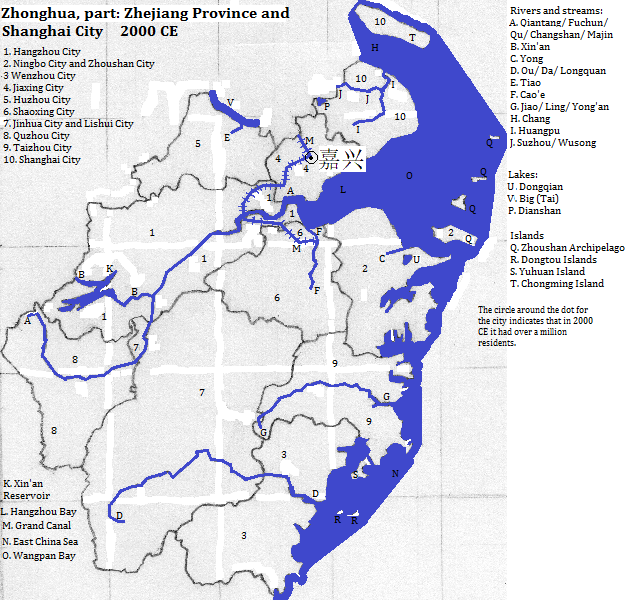嘉兴 (Jiāxīng)
嘉兴1 (Jiāxīng) is a city centered where the current course of the Grand Canal (in its south to north general course) turns from eastward to northward, in 浙江2 (Zhèjiāng) Province, 中华3 (Zhōnghuá) People's Republic. Only in the 20th century did its population grow so large (metropolitan population of 3.497 million).4 Perhaps the tallest building (as of early winter 2016) is Jiahui Square (355 feet).5
Tourists like Wuzhen Ancient Water Town, located in the subordinate city (shi) of Tongziang.6 UNESCO honors, as part of a World Heritage Site, the Jiāxīng-Hángzhōu section of the old course of the Jiangnan Canal; the part nearer Jiāxīng is in the shi (city).
| Year | Population | Political entity |
| 2000 CE | 2,769,0007| 中华 (Zhōnghuá or Chinese) People's Republic) | |
Historical Map

External references
Downtown Jiāxīng, Zhèjiāng Province, Zhōnghuá People's Republic
Footnotes
1. Jiāxīng or Chia-hsing or Jyasying are transliterations from Pŭtōnghuà Chinese. It is also called Kashing (former postal designation based on the Nanjing dialect). The first character means good or commend and the second flourish or prosper. In the Wu dialect group it transliterates as Gāshīng.
2. Zhèjiāng or Che-Chiang or Jejyang in transliterated Pŭtōnghuà Chinese. It is also called Chekiang (former postal designation based on the Nanjing dialect). The first character is a phonetic marker coupled with the water radical. In reconstructed Old Chinese it was pronounced like tet, and was a proto-Wu term for the Yue people according to https://en.wikipedia.org/wiki/Zhejiang, accessed August 10, 2016. The second character means river.
3. Zhōnghuá or Chung-hua or Junghwa in transliterated Pŭtōnghuà Chinese. The first character means central and the second means Chinese/ illustrious/ flowery. China is its English name. In the Wu dialect group it transliterates as Tsonkoh.
4. The shi had 4.502 million according to the 2010 census. Omitting the two xiàn reduces this to 3.497 million. (2010 census figures are from https://en.wikipedia.org/wiki/Jiaxing, accessed July 31, 2016.)
5. It is the only building listed for the city in emporis.com, accessed Dec. 8, 2016.
6. Tourist sites for the province are from two sites: http://www.china.org.cn/top10/2012-06/04/content_25538813.htm (Zhejiang tourism, accessed August 3, 2016)--for the first five only as the rest errored out, and these were really the top five as the list was backward-ordered; however the first one (that is, number ten) was eliminated. The rest are from https://www.tripadvisor.com/Attractions-g297468-Activities-Zhejiang.html--the top five, accessed August 3, 2016.
7. https://www.citypopulation.de/php/china-zhejiang-admin.php (accessed Aug. 2, 2016) provided the prefectural and sub-prefectural populations for 2000. https://en.wikipedia.org/wiki/List_of_administrative_divisions_of_Zhejiang, accessed on the same date provided the list of administrative changes 2000 to date, but none were relevant to Jiāxīng. Excluding the same two xiàn as 2010 brings the metropolitan population down to 2.769 million, with the shi without exclusions having 3.583 million in 2000 CE.

